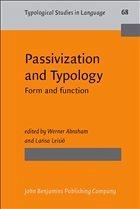Main description:
Is the passive a unified universal phenomenon? The claim derived from this volume is that the passive, if not universal, has become unified according to function. Language as a means of communication needs the passive, or passive-like constructions, and sooner or later develops them based on other voices (impersonal active, middle, reflexive), specific semantic meanings such as adversativity, or tense-aspect categories (stative,perfect, preterit). Certain contributors review the passives in various languages and language groups, including languages rarely discussed. Another group of contributors takes a novel theoretical approach toward passivization within a broad typological perspective. Among the languages discussed are Vedic, Irish, Mandarin Chinese, Thai, Lithuanian, Mordvin, and Nganasan, next to almost all European languages. Various theoretical frameworks such as Optimality Theory, Modern Structuralist Approaches, Role and Reference Grammar, Cognitive Semantics, Distributed Morphology, and Case Grammar have been applied by the different authors.
Table of contents:
- Contributor's addresses
- Abbreviations
- Introduction: Passivization and typology
- Active-passive and reflexives
- Passives in Lithuanian (in comparison with Russian)
- Passive and middle in Indo-European
- Triggers - aspectual, semantic, and discourse-pragmatic: case studies
- Pragmatic nature of Mandarin passive-like constructions
- Development of thùuk passive marker in Thai
- The passives of Modern Irish
- The passive in Erzya-Mordvin folklore
- Grammatical voice and tense-aspect in Slavic
- Passive in Nganasan
- Actor demotion
- 'Agent defocusing' revisited
- Relations between Actor-demoting devices in Lithuanian
- Grammaticalization in long-term diachrony
- The rise and grammaticalization paths of Latin fieri and facere as passive auxiliaries
- Grammatical relations in passive clauses
- Argument structure and case
- Two types of detransitive constructions in the dialects of Japanese
- Passive and argument structure
- Case-driven agree, EPP, and passive in Turkish
- A unique feature of the direct passive in Japanese
- Passive as a feature-suppression operation
- Event semantics - Aspectual and semantic triggers
- The compositional nature of the passive
- The impersonal passive
- Simple preterit and composite perfect tense
- Author index
- Subject index
Is the passive a unified universal phenomenon? The claim derived from this volume is that the passive, if not universal, has become unified according to function. Language as a means of communication needs the passive, or passive-like constructions, and sooner or later develops them based on other voices (impersonal active, middle, reflexive), specific semantic meanings such as adversativity, or tense-aspect categories (stative,perfect, preterit). Certain contributors review the passives in various languages and language groups, including languages rarely discussed. Another group of contributors takes a novel theoretical approach toward passivization within a broad typological perspective. Among the languages discussed are Vedic, Irish, Mandarin Chinese, Thai, Lithuanian, Mordvin, and Nganasan, next to almost all European languages. Various theoretical frameworks such as Optimality Theory, Modern Structuralist Approaches, Role and Reference Grammar, Cognitive Semantics, Distributed Morphology, and Case Grammar have been applied by the different authors.
Table of contents:
- Contributor's addresses
- Abbreviations
- Introduction: Passivization and typology
- Active-passive and reflexives
- Passives in Lithuanian (in comparison with Russian)
- Passive and middle in Indo-European
- Triggers - aspectual, semantic, and discourse-pragmatic: case studies
- Pragmatic nature of Mandarin passive-like constructions
- Development of thùuk passive marker in Thai
- The passives of Modern Irish
- The passive in Erzya-Mordvin folklore
- Grammatical voice and tense-aspect in Slavic
- Passive in Nganasan
- Actor demotion
- 'Agent defocusing' revisited
- Relations between Actor-demoting devices in Lithuanian
- Grammaticalization in long-term diachrony
- The rise and grammaticalization paths of Latin fieri and facere as passive auxiliaries
- Grammatical relations in passive clauses
- Argument structure and case
- Two types of detransitive constructions in the dialects of Japanese
- Passive and argument structure
- Case-driven agree, EPP, and passive in Turkish
- A unique feature of the direct passive in Japanese
- Passive as a feature-suppression operation
- Event semantics - Aspectual and semantic triggers
- The compositional nature of the passive
- The impersonal passive
- Simple preterit and composite perfect tense
- Author index
- Subject index

